Table of Contents
Do you wish to have your personal masseuse at home, who is always ready to alleviate the tension in your back or any other part of your body? This luxury isn’t exclusive to professional athletes. You can achieve it by getting a foam roller for your home gym, which, while not a complete substitute for a live masseuse, can work effectively on stiff muscles or trigger points. That’s why you’ll find this fitness tool in almost every athlete’s household. In addition to other benefits, this article will also explain how to select and use a foam massage roller.
What Is a Foam Roller?
A foam roller, also known as a massage roller, is a fitness tool that allows you to self-massage the muscles all over your body. It is used both before and after workouts, as part of recovery, and as a therapeutic aid during rehabilitation. These rollers are made of foam with varying levels of hardness and come in different sizes and surface types. There are even smart foam rollers with built-in vibrating cores, which are primarily used to release tension or warm up larger muscle groups such as the back, buttocks, thighs, or calves. When targeting smaller muscles, like those in the feet or between the shoulder blades, massage balls are more effective.
The popularity of foam rollers has seen a rise in recent years, especially among runners, strength athletes, crossfitters, and other active individuals. However, people who might spend their entire day sitting or standing at work also use them in the evening to stretch, relax, and massage their muscles.
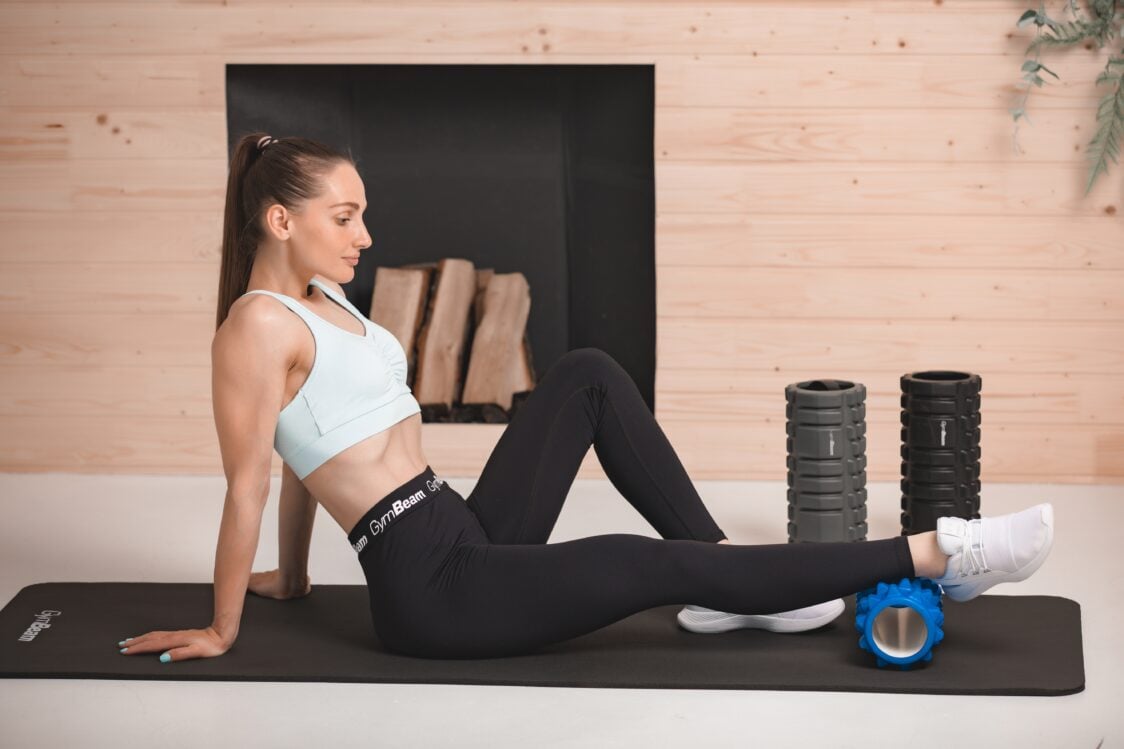
How Does a Foam Roller Work?
Foam rollers are able to apply pressure to the muscles, improving blood circulation, and also target fascias. They are primarily used for warming up muscles, stretching, and myofascial release techniques (Self-Myofascial Release – SMR). [1]
By targeting the fascias, which are connective tissues that envelop muscles and are situated between individual muscle fibres, they provide support to the muscles, give them shape, and help keep them in the right place. Simultaneously, they allow for smooth, unrestricted movement. Additionally, they play a role in transmitting energy and signals from the nervous system to the muscles (connecting the brain to the muscle). However, when fascias become stiff, it can negatively affect the function of the entire muscle. In addition to reduced mobility, this can also lead to the formation of so-called trigger points, which are small, painful knots that can be felt within the muscle. The most common causes are muscle overuse, inappropriate exercises, injuries, or psychological stress. [2-3]
A foam roller will assist you in targeting stiff muscle areas or trigger points and massaging them. However, the benefits of its regular use go beyond that.
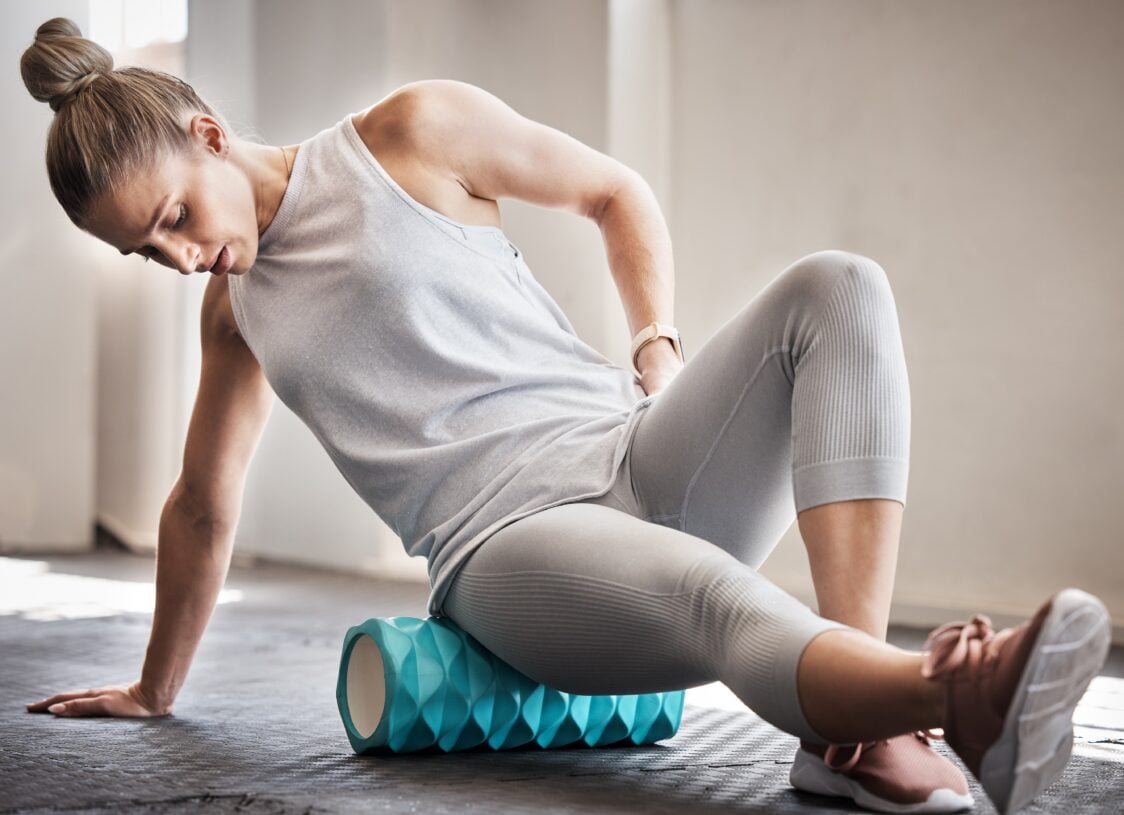
Why Should You Use a Foam Roller?
Those who have experience with using foam rollers can surely understand why some people love and hate them at the same time. Especially when dealing with sore muscles, using a foam roller can be quite painful during the first few seconds. However, after a while, the welcome relief comes to compensate for the initial discomfort. In addition to quick relief, you can also look forward to other benefits of regular rolling.
1. It can positively impact muscle flexibility
When you use a foam roller on the muscle group you intend to exercise before doing so, your muscles will warm up and receive better blood flow. This allows them to receive more oxygen and other nutrients necessary for muscle function. Additionally, rolling can release any areas of stiffness, which also leads to improved mobility. According to studies, these effects can even result in an increased range of motion of joints in the massaged area. In general, rolling yields better results than traditional stretching before a workout. [9-11]
2. It can help reduce muscle soreness after a workout
Many people turn to foam rolling with the expectation that it will reduce muscle soreness after exercising and accelerate their recovery. Several studies have also confirmed that self-myofascial release with the help of a foam roller after a workout can lead to a reduction in muscle soreness (Delayed Onset Muscle Soreness – DOMS) 24 and 48 hours after the workout. This can translate into better performance in subsequent workouts. Therefore, this technique is popular among athletes with demanding training or competition schedules. [12-13]
However, rolling immediately after a workout may not suit everyone, and some prefer to use this technique a few hours later at home or even the next day as part of their recovery. Therefore, it’s important for you to find what works best for you.
You can learn more about other ways how to support recovery in the article: The Best Techniques for Regeneration, Muscle Soreness and Fatigue After Training
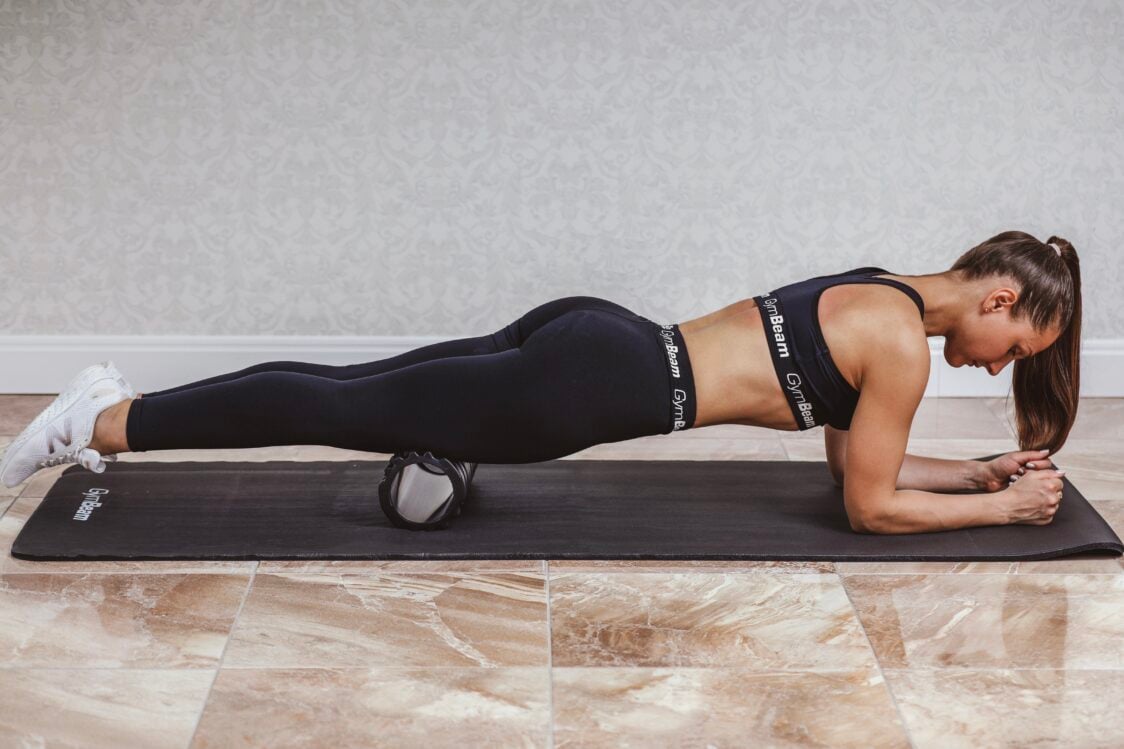
3. It can support athletic performance
Rolling before and after a workout can contribute to better performance. Before exercise, it helps prepare your muscles for the stress and simultaneously reduce the feeling of fatigue, allowing you to handle more strenuous training. As mentioned earlier, after the workout, foam rolling can lead to less muscle soreness in the following days. When your muscles don’t hurt as much on your next workout, it’s likely to have a positive impact on your performance. [11]
4. It can help alleviate back pain
Having a stiff and painful back is something that almost everyone will experience at some point in their life. Simply sitting for an extended period of time, making a sudden movement, or overexerting yourself during a workout can lead to this. To alleviate the pain, myofascial release using a foam roller can be helpful. However, if rolling your back causes even more pain, it’s better to consider traditional back massage or consult a physiotherapist or orthopaedic specialist. It could be a more serious issue. [16]
5. Other potential effects
Some individuals also use foam rollers in their battle against cellulite. They believe that it can smooth out fatty dimples, which are associated with the aforementioned fascias. However, the truth is that foam rolling leads only to temporary skin smoothing, primarily due to improved blood circulation. Currently, there is no evidence to suggest that rolling leads to the long-term removal of cellulite. [14]
If you want to learn more about what causes cellulite and which methods can help eliminate it, read the article: Cellulite – What Causes It and How to Get Rid of It?
You might be interested in these products:
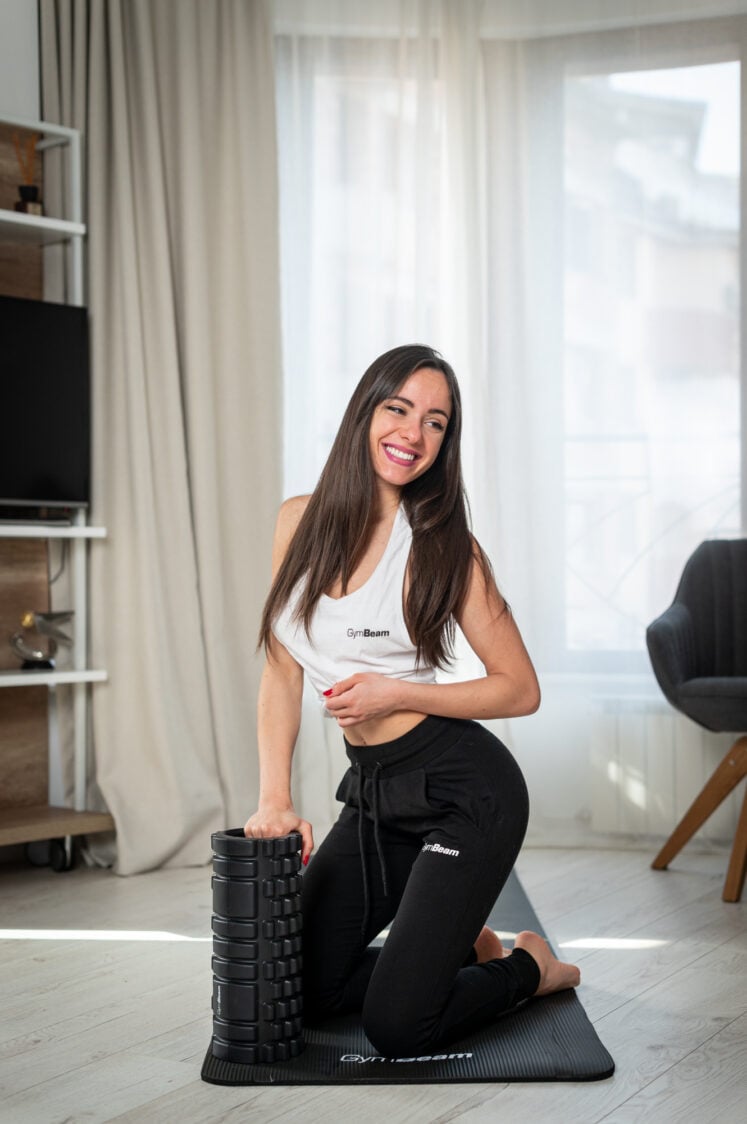
How to Choose a Foam Roller?
When you decide to get a foam roller, you’ll soon discover that there are numerous options available. They come in various lengths, hardness levels, with textures, and without. How to navigate through this and find the best foam roller according to your needs?
Types of Foam Rollers
1. Basic foam roller
- A foam roller is typically made of soft foam and doesn’t have any ridges on its surface.
- It can have various levels of hardness.
- The massage with it won’t be as intense, which is sure to be appreciated, particularly by people who are just starting with foam rollers.
- You can also reach for it in case you experience strong muscle pain, as a ridged roller might do more harm than good.
- At the same time, you should be aware that it won’t reach the deeper layers of muscle tissue.
- In addition to stretching, it’s also used for balance exercises or as a fitness aid in Pilates or yoga.
- Longer foam rollers are ideal for massaging the back, while shorter ones allow you to target smaller muscle groups more easily. [4]
2. Ridged foam roller
- This type of roller features a hollow core and a firmer textured surface.
- Thanks to the 3D design, it’s perfect for deep tissue muscle massage and releasing stiff areas.
- That said, even beginners don’t need to be afraid of using it, as you can control the intensity of the massage by adjusting how much pressure you apply to it with your body.
- There are also foam rollers with smaller or larger ridges that reach deeper into the muscles and are suitable for releasing trigger points.
- You can find them in various widths and lengths. The same rule applies to them as well: longer ones are suitable for larger muscle groups, and shorter ones for smaller muscles [4]
3. Vibrating foam roller
- A vibrating foam roller looks similar to the basic ridged foam roller.
- It features a vibrating core that allows you to adjust the intensity.
- Vibration can make the massage more enjoyable and effective. [5]
For those of you who can’t decide on just one roller, there’s also the 2-in-1 or 3-in-1 options available. Typically, such a tool consists of a large smooth roller with a firmer ridged roller inserted into it, and possibly a massage roller stick as well. This way, you’ll have multiple tools at your disposal to massage different parts of your body with varying intensities.
When Should You Use a Foam Roller?
There are many situations where a foam roller can become your best friend. Whether it’s for stretching or the day after a tough leg workout when it helps loosen up your sore thighs.
1. Before a workout
Massaging warms up the muscles as well as improves blood circulation. This allows your muscles to be better prepared for the stress, reducing the risk of injury during the workout. [6]
2. After a workout
After exercise, it will help you release your entire body as part of the cool-down phase. You’ll also promote blood circulation in the muscles, aiding in the removal of waste products (metabolites) generated during exercise. However, it’s advisable to use a smooth foam roller for this purpose. Your muscles have likely already been put through their paces, so there’s no need to further stress them with a roller that has huge ridges. [6-7]
3. As part of recovery
Try using the foam roller on the second day after your workout when muscles often hurt the most. It will help improve blood circulation in the specific area, allowing amino acids and other nutrients necessary for recovery to reach it more effectively. It will also flush out metabolites that can cause pain. [7]
If you want to learn more about what else could help speed up your recovery, be sure to check out the article: How to Support Regeneration Using a Massage Gun and Other Tools?
4. Anytime during the day
You can reach for the foam roller anytime you feel that your muscles are stiff or just want to relax. It’s suitable after long hours of sitting at a computer or other sedentary work. Likewise, after a challenging hike, it can bring the desired relief to your back, which carried your backpack all day. Rolling can thus be your reward for a job well done.
Discover our bestsellers:
How to Use a Foam Roller?
Before you start with the rolling, take a moment to read about what to watch out for. [1,8]
- Ideally, perform the rolling exercises after warming up your muscles. A few minutes on a rowing machine or another cardio machine should suffice, or you can do it after your workout when your muscles are still warm.
- Position the roller under your back or another muscle group. Then, lie on it and roll a few centimetres up and down. You can then move it a bit lower or higher and continue with the self-massage.
- You can increase the intensity of the massage by adjusting how much pressure you apply to the roller with your body.
- Make sure to avoid injured areas and open wounds. Massaging may be slightly uncomfortable, even mildly painful during the first few seconds, but it should not cause progressively worsening pain.
- The massaged muscle should be stretched/tensed. For example, when massaging your calves, straighten your leg, and point your toes upward.
- Perform the rolling motion on each muscle group for at least 30 seconds, up to a maximum of 2 minutes. Adjust the duration according to how you feel, and pay attention to how the muscles gradually relax and any pain decreases. Then move on to the next muscle group.
- If you encounter a stiffer spot while rolling, be sure to massage that area more thoroughly.
- Use the foam roller only on muscles. Avoid bones, joints, and the lumbar spine.
- Target larger muscle groups like the back, buttocks, thighs, or calves with the foam roller. If you need to target any smaller muscles or specific problematic areas, use a massage ball.
Foam Roller Exercises
You can easily perform a full-body massage with the help of a foam roller. However, it is most commonly used for releasing tension in the back, buttocks, and thighs. Try the basic exercises listed below, which you can use before every workout.
Make sure to always warm up lightly before rolling. A few minutes of jogging in place, a brisk walk on a treadmill, stationary cycling, or even skipping rope will suffice.
1. Foam Rolling The Back
- Starting position: Place the foam roller under the upper part of your back. Bend your arms at the elbows and place your palms behind your ears or cross your arms on your chest. Bend your legs, keeping your feet as support points flat on the mat.
- Execution: Breathe deeply and start rolling your back up and down on the foam roller. If you feel a stiff spot, focus on it more thoroughly. The massage will be more intense when you apply more of your body weight to the foam roller. During the exercise, you can adjust the roller’s position up or down as needed. Continue for at least 30 seconds.
- Common mistakes: Moving too quickly, rolling over a small area, holding your breath.
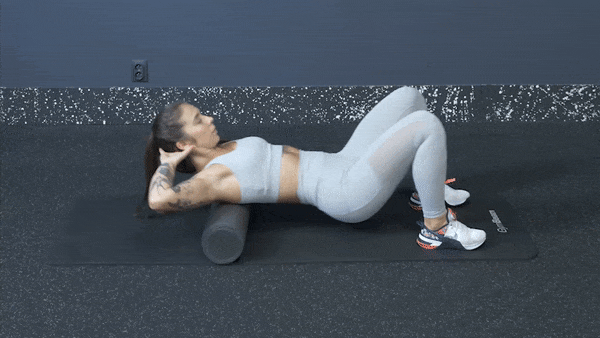
2. Foam Rolling The Buttocks
- Starting position: Sit on the roller, then bend and lift one leg, placing it above the knee of the other supporting leg. Hold it by the ankle with the opposite hand, and place the other palm on the surface for support. Slightly twist your torso to the side of the raised leg.
- Execution: Breathe deeply and start rolling your buttocks up and down on the foam roller. If you feel a stiff spot, focus on it more thoroughly. The massage will be more intense when you apply more of your body weight to the foam roller. During the exercise, you can adjust the roller’s position up or down as needed. Continue for at least 30 seconds, then switch sides.
- Common mistakes: Moving too quickly, rolling over a small area, holding your breath.

3. Foam Rolling the Back of the Thighs
- Starting position: Sit on the mat and place the foam roller under your thigh. Slightly bend your knee and keep your foot off the ground. Bend the other leg and leave the entire foot on the mat. You can also place it on the leg being massaged to increase the intensity of the massage. Place your outstretched hands behind you as support, with your palms on the mat.
- Execution: Breathe deeply and start rolling your thigh up and down on the foam roller. If you feel a tight spot, focus on it more thoroughly. Increasing the pressure with your own body weight will intensify the massage. You can adjust the foam roller’s position up or down as needed during the exercise. Continue for at least 30 seconds, then switch sides.
- Common mistakes: Moving too quickly, rolling over a small area, holding your breath.

4. Foam Rolling the Front of the Thighs
- Starting position: Sit on the mat and place the foam roller under your thigh. Slightly bend your knee and keep your foot off the ground. Bend the other leg and leave the entire foot on the mat. You can also place it on the leg being massaged to increase the intensity of the massage. Place your outstretched hands behind you as support, with your palms on the mat.
- Execution: Breathe deeply and start rolling your thigh up and down on the foam roller. If you feel a tight spot, focus on it more thoroughly. Increasing the pressure with your own body weight will intensify the massage. You can adjust the foam roller’s position up or down as needed during the exercise. Continue for at least 30 seconds, then switch sides.
- Common mistakes: Moving too quickly, rolling over a small area, holding your breath.

Full-Body Exercises With a Foam Roller
You can find additional effective foam roller exercises for the whole body in our video.
What Are the Main Takeaways?
A foam roller is an effective tool for relaxing your muscles across the whole body, supporting recovery, and enhancing athletic performance. You can use it before or after exercise, or at any time during the day when you want to stretch. However, to achieve the best results, always keep in mind the basic rules of foam rolling. These include warming up your muscles before rolling, massaging each muscle group for at least 30 seconds to 2 minutes, and using the foam roller only on muscles. To start off, you can incorporate the aforementioned foam roller exercises for your back, buttocks, and legs into your routine.
If you liked the article and learned something new about foam rollers, feel free to share it with your friends!
[1] Foam Rolling 101: Who Should Do It, When to Do It & How to Do It. – https://www.houstonmethodist.org/blog/articles/2020/jul/foam-rolling-101-who-should-do-it-when-to-do-it-how-to-do-it/
[2] Physiopedia. Fascia. – https://www.physio-pedia.com/Fascia
[3] Physiopedia. Myofascial Pain. – https://www.physio-pedia.com/Myofascial_Pain
[4] REI. How to Choose Foam Rollers. – https://www.rei.com/learn/expert-advice/foam-rollers.html
[5] Greatist. Everything You Need to Know About Using Foam Rollers. – https://greatist.com/fitness/how-choose-the-right-foam-roller
[6] Penney, S. Foam Rolling: Applying the Technique of Myofascial Release. – https://blog.nasm.org/foam-rolling-and-self-myofascial-release
[7] Muscle & Fitness. The Ultimate Guide to Foam Rolling for Recovery. – https://www.muscleandfitness.com/workouts/workout-tips/foam-rolling-total-body-benefits/
[8] Physiotherapy, S. Foam Roller 101: Usage and 10 Exercises to Try. – https://www.stridephysiotherapy.ca/how-to-use-your-foam-roller-top-10-exercises/
[9] Pagaduan, J. C., Chang, S.-Y., & Chang, N.-J. Chronic Effects of Foam Rolling on Flexibility and Performance: A Systematic Review of Randomized Controlled Trials. – https://doi.org/10.3390/ijerph19074315
[10] Konrad, A., Nakamura, M., Tilp, M., Donti, O., & Behm, D. G. Foam Rolling Training Effects on Range of Motion: A Systematic Review and Meta-Analysis. – https://doi.org/10.1007/s40279-022-01699-8
[11] Human Kinetics. The research behind foam rolling. – https://us.humankinetics.com/blogs/excerpt/the-research-behind-foam-rolling
[12] Stull, K. Research in Review: Does foam rolling decrease DOMS and aid performance? – https://blog.nasm.org/fitness/research-review-foam-rolling-decrease-doms-aid-performance
[13] Walker, O. Foam Rolling. – https://www.scienceforsport.com/foam-rolling/
[14] Foam Rolling for Cellulite: Why It Doesn’t Work. – https://www.acefitness.org/resources/pros/expert-articles/6001/foam-rolling-for-cellulite-why-it-doesn-t-work/
[15] Wu, Z., Wang, Y., Ye, X., Chen, Z., Zhou, R., Ye, Z., Huang, J., Zhu, Y., Chen, G., & Xu, X. Myofascial Release for Chronic Low Back Pain: A Systematic Review and Meta-Analysis. – https://doi.org/10.3389/fmed.2021.697986



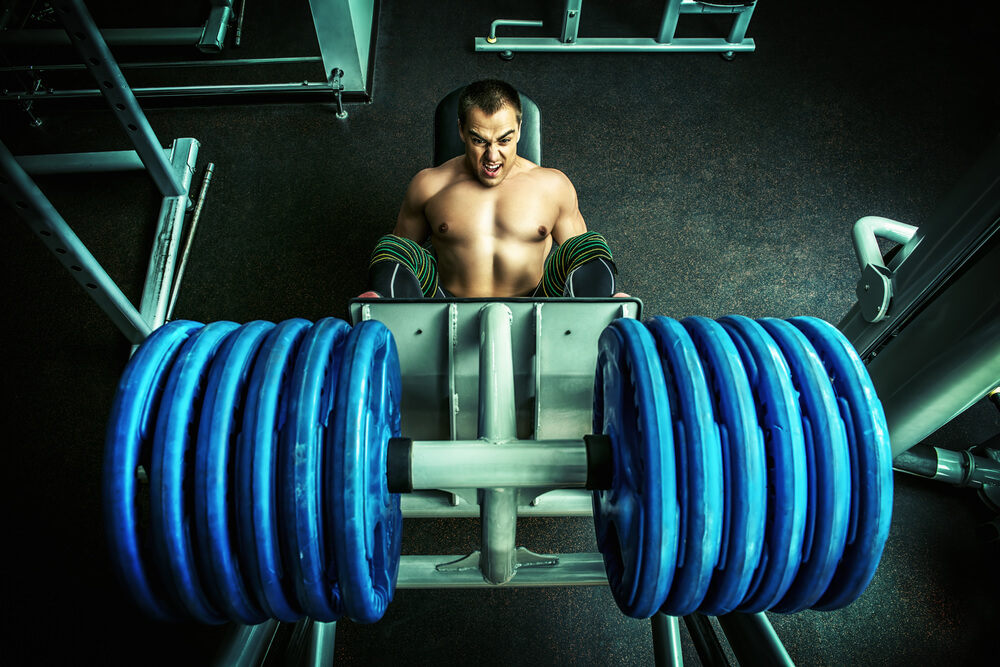


Leave a Reply
You must be logged in to post a comment.